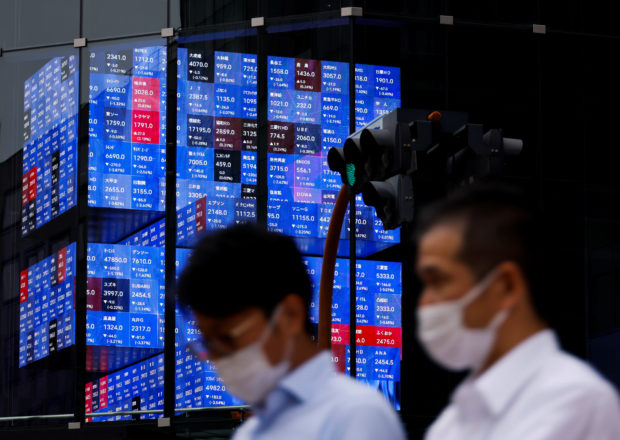Asia shares edge higher, wary of Fed words

People pass by an electronic screen showing Japan’s Nikkei share price index inside a conference hall in Tokyo, Japan.. REUTERS/Issei Kato/File photo
SYDNEY – Asian shares inched higher on Monday with investors anxious to see if Wall Street can sustain its rally as hopes U.S. inflation has peaked will be tested by likely hawkish commentary from the Federal Reserve this week.
“The FOMC Minutes on Wednesday should reinforce the hawkish tones from recent Fed speakers of being nowhere near being done on rates and inflation,” warned Tapas Strickland, a director of economics at NAB.
Markets are still implying around a 50-percent chance the Fed will hike by 75 basis points in September and that rates will rise to around 3.50-3.75 percent by the end of the year.
Hopes for a soft economic landing will also get a health check from U.S. retail sales data that is expected to show a sharp slowdown in spending in July.
There is also a risk earnings from major retailers, including Walmart and Target, could be laced with warnings about a downturn in demand.
Asian markets have to navigate data on China’s retail sales and industrial output for July due later on Monday, which should show some pick up as coronavirus rules were relaxed.
However, figures already out showed new bank lending in China tumbled more than expected in July.
Geopolitical risks also remain high with a delegation of U.S. lawmakers in Taiwan for a two-day trip.
Early Monday, MSCI’s broadest index of Asia-Pacific shares outside Japan firmed 0.1 percent, having bounced 0.9 percent last week.
Japan’s Nikkei edged up 0.5 percent as data showed the economy grew an annualized 2.2 percent in the second quarter, a touch under estimates.
S&P 500 futures and Nasdaq futures were both down around 0.2 percent. The S&P index is almost 17 percent above its mid-June lows and only 11percent from all-time highs amid bets the worst of inflation is past, at least in the United States.
Peak inflation
“The leading indicators we observe provide support for moderation with easing supply pressures, weakening demand, collapsing money supply, declining prices and falling expectations,” said analysts at BofA.
“Key components of headline inflation, including food and energy are also at an inflection point. Both Wall Street and Main Street now expect inflation to moderate.”
The bond market still seems to doubt the Fed can manufacture a soft landing, with the yield curve still deeply inverted. Two-year yields at 3.26 percent are 42 basis points above those for 10-year notes.
Those yields have underpinned the U.S. dollar, though it did slip 0.8 percent against a basket of currencies last week as risk sentiment improved.
The euro was holding at $1.0259, having bounced 0.8 percent last week, though it shied away from resistance around $1.0368. Against the yen, the dollar steadied at 133.36 after losing 1 percent last week.
“Our sense remains that the dollar rally will resume before too long,” argued Jonas Goltermann, a senior economist at Capital Economics.
“It will take a lot more good news on inflation before the Fed changes tack. The minutes from the last FOMC meeting and the Jackson Hole conference may well push back further against the notion that the Fed is ‘pivoting’.”
The pullback in the dollar provided something of a reprieve for gold which was up at $1,799 an ounce, having gained 1 percent last week.
Oil prices eased early on Monday with traders cautious in case progress was made on a possible European-brokered nuclear deal with Iran.
Brent slipped 43 cents to $97.72, while U.S. crude fell 36 cents to $91.73 per barrel.